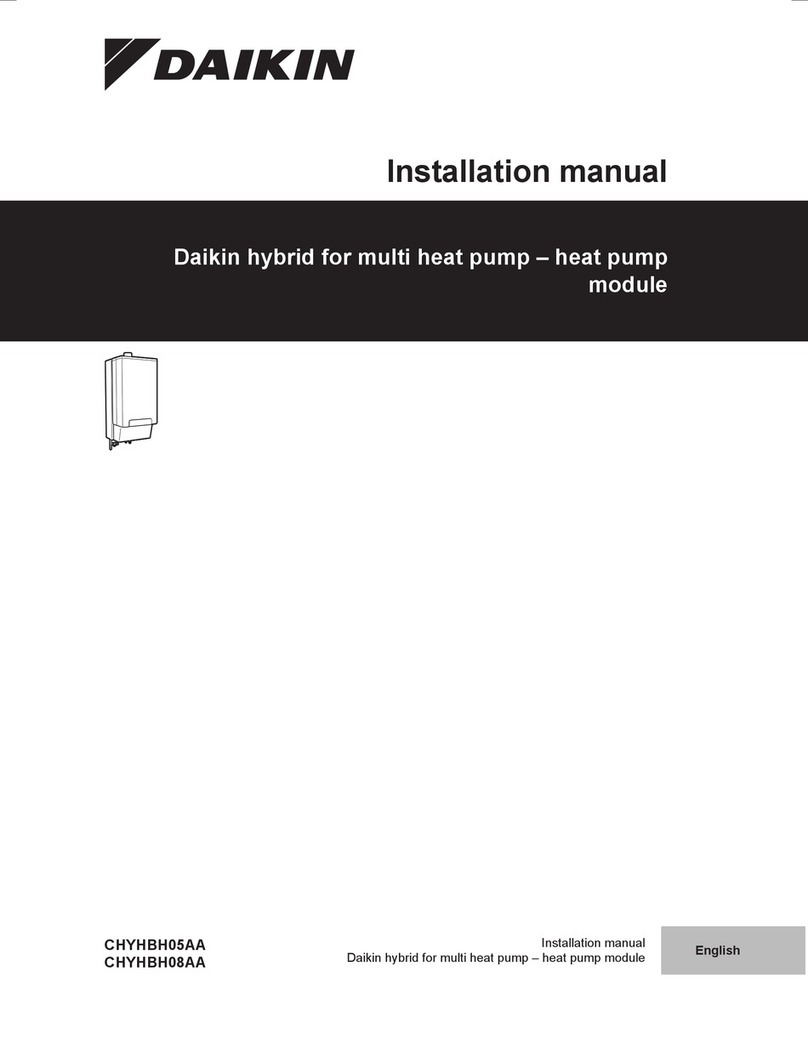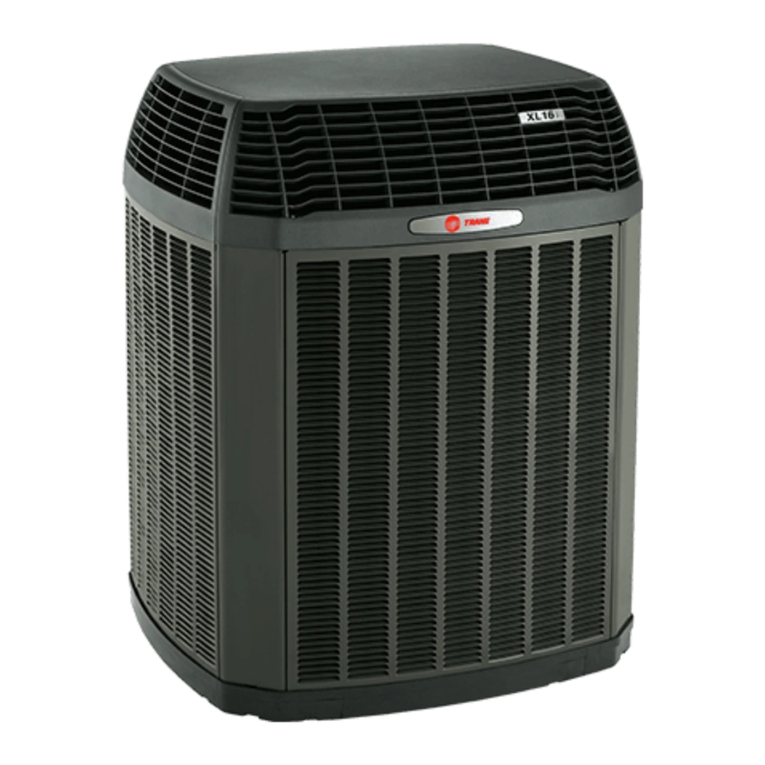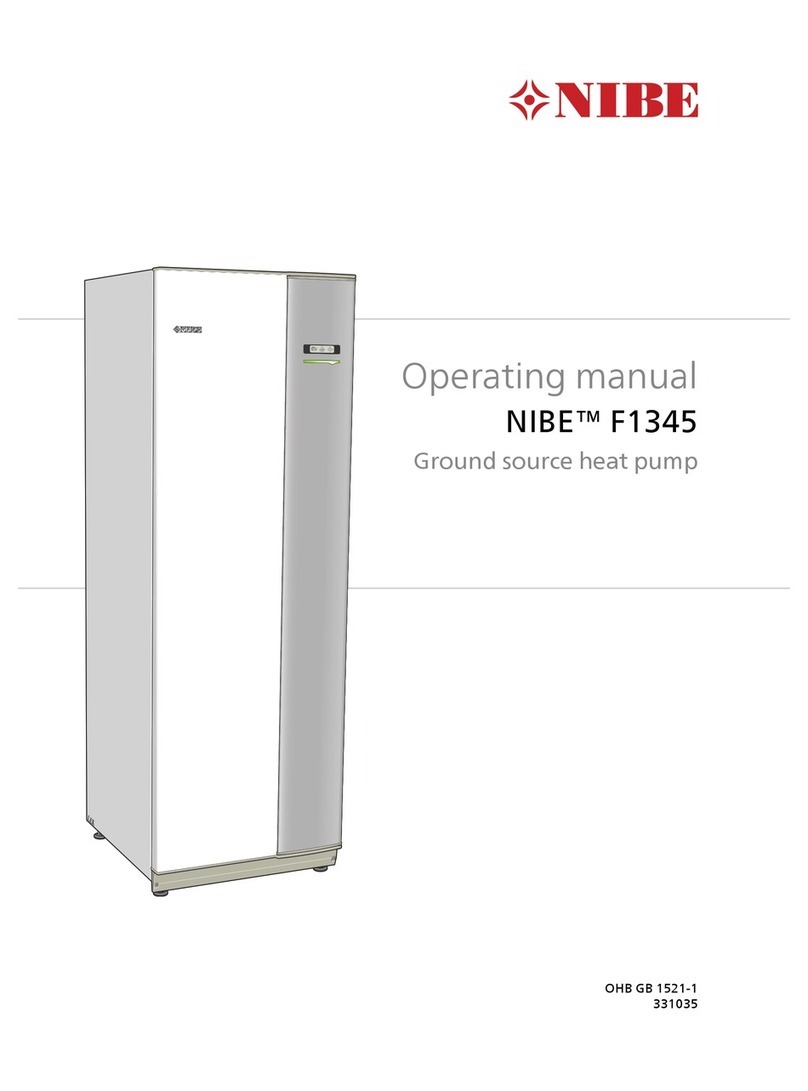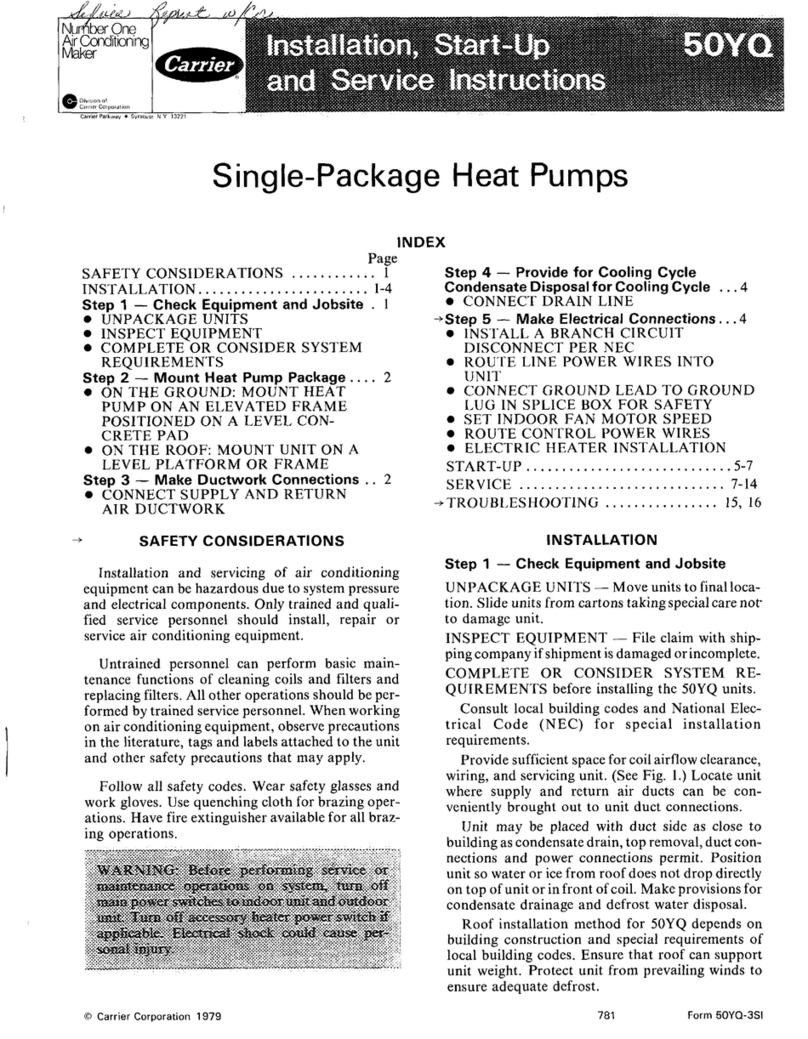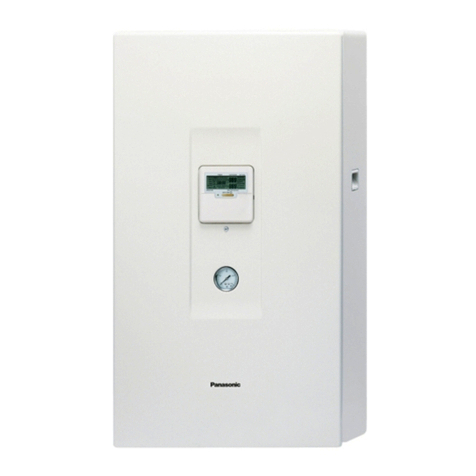Vkin VRHA-18AN1DC/INB User manual

-1-

Heat Pump
MODELS
URH/CA-09WDC
URH/CA-12WDC
URH/CA-18WDC
URH/CA-24WDC
URH/CA-36WDC

Table of Contents
ii
SAFETY CONSIDERATIONS
..........................................................................................................iv
Part1
Specifications............................................................................................................................................ 1
1. Specifications........................................................................................................................................2
1.1 Parameter................................................................................................................................. 2
1.2 Nameplate.................................................................................................................................4
Part2
Exploded views and material code.................................................................................................8
1. Exploded views and material code....................................................................................................9
1.1 Exploded View (indoor unit)VRHA-18/24/36/48AN1DC/INB............................................ 9
1.2 Material Code(indoor unit)VRHA-18/24/36/48AN1DC/INB.............................................10
1.3 Exploded View (indoor unit)VRHA-18/24/36AN1DC/INB................................................ 11
1.4 Material Code(indoor unit)VRHA-18/24/36AN1DC/INB.................................................. 12
1.5 Exploded View (indoor unit)VRHA-48/60AN1DC/INB..................................................... 13
1.6 Material Code(indoor unit)VRHA-48AN1DC/INB............................................................. 14
Part 3
Printed Circuit Board Connector Wiring Diagram................................................................ 15
1. Indoor unit........................................................................................................................................... 16
1.1 VRHA-18/24/36/48AN1DC/INB........................................................................................... 16
2. Outdoor unit........................................................................................................................................ 19
2.1 VRHA-18AN1DC/INB............................................................................................................19
2.2 VRHA-24/36AN1DC/INB...................................................................................................... 25
2.3 VRHA-48AN1DC/INB............................................................................................................31
Part 4
Common Wearing Parts...................................................................................................................... 40
1. Common wearing parts (indoor unit).............................................................................................. 41
1.1 Sensor..................................................................................................................................... 41
1.2 Linear Transformer................................................................................................................ 42
1.3 Pump....................................................................................................................................... 43
1.4 Wired remote control............................................................................................................. 45
2. Common wearing parts (outdoor unit)............................................................................................46
2.1 Sensor..................................................................................................................................... 46
2.2 Fan Motor................................................................................................................................47
2.3 Filter Capacitor.......................................................................................................................50
2.4 Fan motor capacitor.............................................................................................................. 51

Table of Contents
iii
Part 5
Comparison Table...................................................................................................................................................... 53
1. Wired Controller................................................................................................................................. 54
1.1 Function...................................................................................................................................54
1.2 Operating Instructions...........................................................................................................55
1.3 Error Codes and Analysis.....................................................................................................57
2.Pressure Refrigerant Loop Temperature Control Table................................................................ 58
2.1 R410 Table..............................................................................................................................58
3. Sensors Resistance Table................................................................................................................ 59
3.1 Compressor Exhaust Temperature Sensor Resistance.................................................. 59
3.2 Ambient/Indoor/Outdoor Pipe Sensor Resistance............................................................60
Part 6
Appendix..................................................................................................................................................... 61
1. Piping Diagrams.................................................................................................................................62
1.1 Indoor Units............................................................................................................................ 62
1.2 Outdoor Units......................................................................................................................... 63
2. Wiring Diagrams................................................................................................................................ 64
2.1 Indoor Units............................................................................................................................ 64
2.2 Outdoor Units..........................................................................................................................65

Safety Considerations
iv
1. SAFETY CONSIDERATIONS
Read these SAFETY CONSIDERATIONS carefully
before performing any repair work. Comply with these
safety symbols without fail.
Meanings of DANGER,WARNING,CAUTION, and NOTE
Symbols:
DANGER ..............Indicates an imminently
hazardous situation which, if
not avoided, will result in death
or serious injury.
WARNING ............Indicates a potentially
hazardous situation which, if
not avoided, could result in
death or serious injury.
CAUTION .............Indicates a potentially
hazardous situation which, if
not avoided, may result in
minor or moderate injury. It
may also be used to alert
against unsafe practices.
NOTE ...................Indicates situations that may
result in equipment or
property-damage accidents
only.
1.1 Safety Considerations for Repair
DANGER
•
If refrigerant gas leaks during repair or service,
ventilate the area immediately. Refrigerant gas may
produce toxic gas if it comes into contact with
flames. Refrigerant gas is heavier than air and
replaces oxygen. In the event of an accident, a
massive leak could lead to oxygen depletion,
especially in basements, and an asphyxiation
hazard could occur leading to serious injury or
death.
•
Do not start or stop the air conditioner operation
by plugging or unplugging the power cable plug if
a plug is used. Plugging or unplugging the power
cable plug to operate the equipment may cause an
electrical shock or fire.
•
Use parts listed in the service parts list and
appropriate tools to conduct repair work. The use
of inappropriate parts or tools may cause an
electrical shock or fire.
•
Disconnect power before disassembling the
equipment for repairs. Working on the equipment
that is connected to the power supply may cause
an electric shock. If it is necessary to supply
power to the equipment to conduct repairs or to
inspect the circuits, do not touch any electrically
charged sections of the equipment.
•
The step-up capacitor supplies high-voltage
electricity to the electrical components of the
outdoor unit. Discharge the capacitor completely
before conducting repair work. A charged
capacitor may cause an electrical shock.
•
If refrigerant gas is discharged during repair work,
do not touch the discharged refrigerant gas. The
refrigerant gas may cause frostbite.
•
Use only pipes, flare nuts, tools, and other
materials designed specifically for R410A
refrigerant systems. Never use tools or materials
designed for R22 refrigerant systems on an R410A
refrigerant system. Doing so can cause a serious
accident or an equipment failure.
•
Check to see if the parts and wires are mounted
and connected properly, and if the connections at
the soldered or crimped terminals are secure.
Improper installation and connections may cause
excessive heat generation, fire, or electrical shock.
WARNING
•
Prior to disconnecting the suction or discharge
pipe from the compressor at the welded
section,pump-down the refrigerant gas completely
in a well-ventilated place first. If there is refrigerant
gas or oil remaining inside the compressor, the
refrigerant gas or oil can discharge when the pipe
is being disconnected and it may cause an injury.
•
Wear a safety helmet, gloves, and a safety belt
when working at an elevated height of more than
6.5 ft (2 m). Insufficient safety measures may
cause a fall resulting in injury.
•
Do not mix air or gas other than the specified
refrigerant R410A to the refrigerant system. If air
enters the refrigerant systems, it can cause an
excessive high pressure resulting in equipment
damage and injury.
•
When relocating the equipment, check if the new
installation site has sufficient strength to
withstand the weight of the equipment. If the
installation site does not have sufficient strength
and the equipment is not properly secured, the
equipment may fall and cause injury.
•
Securely fasten the outside unit terminal cover
(panel). If the terminal cover/panel is not fastened
properly, dust or water may enter the outside unit
causing fire or electric shock.
•
When relocating the system, keep the refrigerant
circuit free from substances other than the
specified refrigerant (R-410A) such as air. Any
presence of air or other foreign substance in the
refrigerant circuit can cause an abnormal pressure
rise or rupture, resulting in injury.
•
If refrigerant gas leaks, locate the leaking point
and repair it before charging refrigerant. After
charging refrigerant, check for refrigerant leaks. If
the leaking point cannot be located and the repair
work must be stopped, perform a pump-down and
close the service valve to prevent the refrigerant
gas from leaking into the room. The refrigerant gas
itself is harmless, but it may generate toxic gases
if it comes into contact with flames.
CAUTION
•
Do not repair the electrical components with wet
hands. Working on the equipment with wet hands
may cause an electrical shock.
•
Do not clean the air conditioner by splashing water
on it. Washing the unit with water may cause an
electrical shock.

Safety Considerations
v
•
Ground the unit when repairing equipment in a
humid or wet place to avoid electrical shocks.
•
Turn off the power when cleaning the equipment to
prevent internal fans that rotate at high speed from
starting suddenly as they can cause injury.
•
Let the refrigerant lines cool down before
performing any repair work. Working on the unit
when the refrigerant lines are hot may cause
burns.
•
All welding and cutting operations must be done in
a well-ventilated place to prevent the accumulation
of toxic fumes or possibly oxygen deficiency to
occur.
•
Check the grounding and repair it if the equipment
is not properly grounded. Improper grounding may
cause an electrical shock.
•
Measure the insulation resistance after the repair.
The resistance must be 1M or higher. Faulty
insulation may cause an electrical shock.
NOTE
•
Check the drainage of the indoor unit after
finishing repair work. Faulty drainage may cause
water to enter the room resulting in wet floors and
furniture.
•
Do not tilt the unit when removing it. The water
inside the unit may spill resulting in wet floors and
furniture.
•
Dismantling of the unit, disposal of the refrigerant,
oil, and additional parts, should be done in
accordance with the relevant local, state, and
national regulations.
1.2 Safety Considerations for Users
DANGER
•
Never attempt to modify the equipment. Doing so
can cause electrical shock, excessive heat
generation, or fire.
•
If the power cable and lead wires have scratches
or have become deteriorated, have them replaced.
Damaged cable and wires may cause an electrical
shock or fire.
•
Do not use a joined power cable or an extension
cord, or share the same power outlet with other
electrical appliances as it may cause an electrical
shock or fire.
•
Use an exclusive power circuit for the equipment.
Insufficient circuit amperage capacity may cause
an electrical shock or fire.
WARNING
•
Do not damage or modify the power cable.
Damaged or modified power cables may cause an
electrical shock or fire. Placing heavy items on the
power cable or pulling the power cable may
damage the cable.
•
Check the unit foundation for damage on a
continual basis, especially if it has been in use for
a long time. If left in a damaged condition, the unit
may fall and cause injury. If the installation
platform or frame has corroded, have it replaced. A
corroded platform or frame may cause the unit to
fall resulting in injury.
•
If the unit has a power cable plug and it is dirty,
clean the plug before securely inserting it into a
power outlet. If the plug has a loose connection,
tighten it or it may cause electrical shock or fire.
CAUTION
•
After replacing the battery in the remote controller,
dispose of the old battery to prevent children from
swallowing it. If a child swallows the battery, see a
doctor immediately.
•
Never remove the fan guard of the unit. A fan
rotating at high speed without the fan guard is very
dangerous.
•
Before cleaning the unit, stop the operation of the
unit by turning the power off or by pulling the
power cable plug out from its receptacle.
Otherwise an electrical shock or injury may result.
•
Do not wipe the controller operation panel with
benzene, thinner, chemical dust cloth, etc. The
panel may get discolored or the coating can peel
off. If it is extremely dirty, soak a cloth in a
water-diluted neutral detergent, squeeze it well,
and wipe the panel clean. Then wipe it with another
dry cloth.

Specifications
1
Part1
Specifications
1. Specifications........................................................................................................................................2
1.1 Parameter................................................................................................................................. 2
1.2 Nameplate.................................................................................................................................4

Specifications
2
1.Specifications
1.1 Parameter
Model
VRHA-18AN1DC/INB
VRHA-24AN1DC/INB
VRHA-36AN1DC/INB
Power supply
Ph-V-Hz
1,230V,60HZ
Cooling
Capacity
BTU
15690(7840-19100)
21830(11600-26610)
28310(16030-31730)
Input
W
1620(600-2250)
2243(800-2550)
2875(1250-3650)
Rated current
A
7.0(2,65~10.05)
9.78(3.52~11.68)
12.58(5.45-15.98)
EER
BTU/W
9.79
9.78
9.82
Heating
Capacity
BTU
17050(8180-21150)
23540(129600-29340)
30707(17050-37530)
Input
W
1219(600-2080)
1703(800-2400)
2267(1250-3400)
Heating water
GAL/h
25
34
44
Rated current
A
5.31(2.65~10.05)
7.44(3.52-11.01)
9.88(5.45-14.88)
COP
BTU/W
13.98
13.81
13.54
First hour water production
GAL/h
70
75
100
water pump
Input (L/M/H)
W
55/70/100
55/70/100
135/190/245
Rated current
A
0.25/0.35/0.45
0.25/0.35/0.45
0.60/0.85/1.10
Tank unit
Dimension (D*H)
Inch
φ21.8X58.7
φ23.4X60.8
φ27.3X61.6
Packing (W*H*D)
Inch
24.6X24.6X61.2
26.1X26.1X63.6
30.4X30.4X66.3
Net/Gross weight
Ibs
96.8/105.8
105.8/114.8
131.6/140.4
Indoor unit
Dimension (W*H*D)
Inch
29×18.5×9.2
29×18.5×9.2
29×18.5×9.2
Packing (W*H*D)
Inch
31×22.8×11.3
31×22.8×11.3
31×22.8×11.3
Net/Gross weight
Ibs
67.5/69.7
72.0/74.5
76.5/78.7
Outdoor unit
Dimension (W*H*D)
Inch
33X23.7X11.1
32.3X27.7X12.1
34.3X31.2X14
Packing (W*H*D)
Inch
38.2X25X15.6
37.8X29.1X16
40X32.8X17.7
Net/Gross weight
Ibs
90/94.4
104.6/108.8
128.2/132.5
Noise level
Indoor
dB(A)
30-40
30-40
34-46
Outdoor
dB(A)
52
54
55
Outdoor air flow
cfm
1058
1352
1647
Design pressure
Psi
600
600
600
MAX.Pipe Length
Ft
32.81
49.21
49.21
MAX.Height Difference
Ft
26.25
32.81
32.81
Pipe Size Liquid/Gas
Inch
1/4 - 1/2
3/4 - 5/8
3/4 - 5/8
Refrigerant
R410a
R410a
R410a
Cooling water range
℉
42-88
42-88
42-88
Heating water range
℉
68 - 140
68 - 140
68 - 140
Ambient temp
℉
-13 - 116
-13 - 116
-13 - 116
Water tank volume
GAL
66
80
106
Rated cooling test conditions:Outdoor dry bulb temperature/Wet bulb temperature95.0℉\75.0℉Influent temperature:54.0℉Effluent temperature:
45.0℉
Rated heating test conditions:Outdoor dry bulb temperature/Wet bulb temperature47.0℉\43.0℉Influent temperature:86.0℉Effluent temperature:
The difference between the fixed-frequency and frequency of::
Fixed-frequency machine: the outdoor unit operating ambient temperature range is relatively narrow (19-109 ℉) and can not adjust the size of the
cooling / heating capacity of the indoor temperature changes, the machine open between stops, the indoor temperature fluctuations, feels suddenly cold
suddenly hot.
Frequency Machine: the outdoor unit operating ambient temperature range is wide (-13-126 ℉) and can change depending on the temperature and
adjust the size of the room cooling / heating capacity, the indoor temperature a smooth transition, the temperature fluctuation is small, automatic climate
control, power consumption energy-saving effect is remarkable.

Specifications
3
Model
VRHA-48AN1DC/INB
VRHA-60AN1DC/INB
VRHA-86AN1DC/INB
Power supply
Ph-V-Hz
1,230V,60HZ
3,380~415V,60HZ
3,380~415V,60HZ
Cooling
Capacity
BTU
37180(23880-45720)
51860(27970-54590)
85290(45030-89050)
Input
W
3818(1650-4950)
5352(2100-5900)
8834(4380-10850)
Rated current
A
16.98(7.19-21.89)
23.32(9.18-25.88)
13.43(6.66-15.98)
EER
BTU/W
9.75
9.68
9.62
Heating
Capacity
BTU
40940(26610-49130)
56970(30020-59700)
88020(47080-99620)
Input
W
3037(1650-4650)
4417(2100-5700)
7411(4380-10100)
Heating water
GAL/h
55
78
120
Rated current
A
13.2(7.19-20.84)
19.28(9.18-24.98)
11.26(6.66-15.35)
COP
BTU/W
13.47
12.89
11.87
First hour water production
GAL/h
150
205
315
water pump
Input (L/M/H)
W
135/190/245
135/190/245
245/308/380
Rated current
A
0.60/0.85/1.10
0.60/0.85/1.10
1.10/1.34/1.66
Tank unit
Dimension (D*H)
Inch
φ29.6X71.7
φ33.5X79.6
φ33.5X83.1
Packing (W*H*D)
Inch
33.2X33.2X75.7
Net/Gross weight
Ibs
145.6/155.3
176.6/180
208.1/215.6
Indoor unit
Dimension (W*H*D)
Inch
29×18.5×9.2
29×18.5×9.2
29×18.5×9.2
Packing (W*H*D)
Inch
31×22.8×11.3
31×22.8×11.3
31×22.8×11.3
Net/Gross weight
Ibs
81.0/83.2
90.0/92.2
108.0/112.2
Outdoor unit
Dimension (W*H*D)
Inch
49.1X32.4X12.1
49.5X36.3X15.2
56.5X23.8X54.6
Packing (W*H*D)
Inch
49.5X37.8X16
50X41.7X19.1
61.6X25X58.5
Net/Gross weight
Ibs
211.5/231.7
229.5/249.7
409.0/434.2
Noise level
Indoor
dB(A)
34-46
34-46
38-52
Outdoor
dB(A)
58
60
64
Outdoor air flow
cfm
2117
3294
4823
Design pressure
Psi
600
600
600
MAX.Pipe Length
Ft
65.62
82.02
98.43
MAX.Height Difference
Ft
49.21
49.21
82.02
Pipe Size Liquid/Gas
Inch
1/2 - 3/4
1/2 - 3/4
1/2 - 7/8
Refrigerant
R410a
R410a
R410a
Cooling water range
℉
42-88
42-88
42-88
Heating water range
℉
68 - 140
68 - 140
68 - 140
Ambient temp
℉
-13 - 116
-13 - 116
-13 - 116
Water tank volume
GAL
160
212
333
Rated cooling test conditions:Outdoor dry bulb temperature/Wet bulb temperature95.0℉\75.0℉Influent temperature:54.0℉Effluent temperature:
Rated heating test conditions:Outdoor dry bulb temperature/Wet bulb temperature47.0℉\43.0℉Influent temperature:86.0℉Effluent temperature:
The difference between the fixed-frequency and frequency of::
Fixed-frequency machine: the outdoor unit operating ambient temperature range is relatively narrow (19-109 ℉) and can not adjust the size of the
cooling / heating capacity of the indoor temperature changes, the machine open between stops, the indoor temperature fluctuations, feels suddenly cold
suddenly hot.
Frequency Machine: the outdoor unit operating ambient temperature range is wide (-13-126 ℉) and can change depending on the temperature and
adjust the size of the room cooling / heating capacity, the indoor temperature a smooth transition, the temperature fluctuation is small, automatic climate
control, power consumption energy-saving effect is remarkable.

Specifications
4
1.2 Nameplate
VRHA-18AN1DC/INB

Specifications
5
VRHA-24AN1DC/INB

Specifications
6
VRHA-36AN1DC/INB

Specifications
7
VRHA-48AN1DC/INB

Exploded Views And Material Code
8
Part2
Exploded views and material
code
1. Exploded views and material code....................................................................................................9
1.1 Exploded View (indoor unit)VRHA-18/24/36/48AN1DC/INB............................................ 9
1.2 Material Code(indoor unit)VRHA-18/24/36/48AN1DC/INB.............................................10
1.3 Exploded View (indoor unit)VRHA-18/24/36AN1DC/INB................................................ 11
1.4 Material Code(indoor unit)VRHA-18/24/36AN1DC/INB.................................................. 12
1.5 Exploded View (indoor unit)VRHA-48/60AN1DC/INB..................................................... 13
1.6 Material Code(indoor unit)VRHA-48AN1DC/INB............................................................. 14

Exploded Views And Material Code
9
1. Exploded views and material code
1.1 Exploded View (indoor unit)VRHA-18/24/36/48AN1DC/INB

Exploded Views And Material Code
10
1.2 Material Code(indoor unit)VRHA-18/24/36/48AN1DC/INB
NO.
NAME
Q'TY
1
Exhaust Pipe
1
2
Inlet pipe
1
3
Outlet pipe
1
4
Electrical box
1
5
Main Board
1
6
Terminal
1
7
Control panel
1
8
Clasp hands
2
9
Cable Glands
3
10
Gas valve
1
11
Liquid valve
1
12
Outlet water connection
1
13
Inlet Pipe connection
1
14
Nylon goblet
4
15
Water Pump
1
16
Plate in bracket
1
17
Panel
1
18
Plate heat exchanger
1
19
Box tank
1
20
Electrical cover
1
21
Fixing piece
1
22
Press clip
1
23
Locks
1
24
Linear transformer
1

Exploded Views And Material Code
11
1.3 Exploded View (indoor unit)VRHA-18/24/36AN1DC/INB

Exploded Views And Material Code
12
1.4 Material Code(indoor unit)VRHA-18/24/36AN1DC/INB
NO.
NAME
Q'TY
VRHA-18AN1DC/INB
VRHA-24AN1DC/INB
VRHA-36AN1DC/INB
1
Top panel
1
13.A.008-13008002
13.A.008-13008003
13.A.008-13008004
2
Back grill
1
13.A.009-13009002
13.A.009-13009003
13.A.009-13009004
3
Axial fan
1
16.B.001-16001011
16.B.001-16001012
16.B.001-16001013
4
Condenser
1
19.B.001-19001010
19.B.001-19001014
19.B.001-19001017
5
Handle
1
16.A.005-16005001
16.A.005-16005009
16.A.005-16005009
6
Front grill
1
16.A.005-16005006
16.A.005-16005048
16.A.005-16005008
7
Front panel
1
13.A.007-13007003
13.A.007-13007004
13.A.007-13007005
8
Bottom plate
1
13.A.001-13001013
13.A.001-13001018
13.A.001-13001022
9
Compressor Capacitor
1
10
Compressor
1
13.A.003-13003010
13.A.003-13003015
13.A.003-13003020
11
Reactance
1
27.J.002-27002002
27.J.003-27003001
27.J.003-27003001
12
Motor bracket
1
16.F.008-16008002
16.F.008-16008007
16.F.008-16008004
13
Outdoor motor
1
18.A.001-18001003
18.A.001-18001014
18.A.001-18001014
14
Outdoor fan
1
24.D.001-24001006
24.D.001-24001008
24.D.001-24001010
15
Four-way valve
1
12.C.006-12006004
12.C.006-12006003
12.C.006-12006002
16
Front panel
1
13.A.002-13002004
17
Gas valve
1
21.A.001-21001001
21.A.001-21001005
21.A.001-21001007
18
Liquid valve
1
21.A.002-21002001
21.A.002-21002006
21.A.002-21002007
19
Modules
1
12.C.007-12007002
12.C.007-12007003
12.C.007-12007004
20
Solenoid coil
1
27.J.001-27001003
27.J.001-27001005
27.J.001-27001006
21
Right side panel
1
13.A.006-13006003
13.A.006-13006005
13.A.006-13006006
22
Electrical Inductance
1
16.A.005-16005004
16.A.005-16005004
16.A.005-16005007
23
Capacitance clip
1
13.A.014-13014001
24
Film Capacitor
1
25
Retaining clip
1
16.A.005-16005050
16.A.005-16005050
16.A.005-16005050
26
Electrical box
1
13.A.011-13011002
13.A.011-13011004
13.A.011-13011004
27
Fan start capacitor
1
30.B.001-30001002
30.B.001-30001003
30.B.001-30001006
28
Control PCB
1
26.B.003-26003004
26.B.003-26003005
26.B.003-26003006
29
Modules
1
26.B.001-26001003
26.B.001-26001001
26.B.001-26001001
30
Heatsink
1
26.B.001-26001003
26.B.001-26001001
26.B.001-26001001
31
Motor bracket
1
13.A.004-13004009
13.A.004-13004013
13.A.004-13004018
32
Electronic expansion
valve
1
12.C.007-12007002
12.C.007-12007003
12.C.007-12007004
33
Pressure protection
2

Exploded Views And Material Code
13
1.5 Exploded View (indoor unit)VRHA-48/60AN1DC/INB

Exploded Views And Material Code
14
1.6 Material Code(indoor unit)VRHA-48AN1DC/INB
NO.
NAME
Q'TY
VRHA-48AN1DC/INB
1
Modules
1
26.B.001-26001006
2
Control board
1
26.B.003-26003008
3
Power Plate
1
26.B.003-26003001
4
PFC inductor
1
27.J.003-27003001
5
Terminal Block
1
27.A.001-27001009
6
Left Fence
1
13.A.009-13009006
7
Partition plate
1
13.A.003-13003022
8
After fencing
1
13.A.009-13009005
9
Four-way valve
1
10
Buckle
1
16.A.008-16008094
11
Right side plate
1
13.A.006-13006007
12
Back to the trachea
1
22.A.003-22003040
13
Exhaust pipe
1
22.A.002-22002040
14
Gas valve
1
21.A.001-21001007
15
Liquid valve
1
21.A.002-21002007
16
Electronic expansion valve
1
20.B.001-202001004
17
Reservoir
1
18
rubber pad
1
18.B.001-18001039
19
Compressor
1
18.A.001-18001012
20
Chassis
1
13.A.001-13001024
21
Motor bracket
1
13.A.004-13004021
22
Motor
1
24.D.001-24001007
23
Blade
1
16.B.001-16001012
24
Pumping hands
1
16.A.005-16005009
25
Net
1
16.A.005-16005048
26
Cover
1
13.A.008-13008005
27
Electric lid
1
13.A.012-13012006
28
Electrical box
1
13.A.011-13011006
29
Condenser
1
19.B.001-19001020
This manual suits for next models
5
Table of contents
Popular Heat Pump manuals by other brands

Carrier
Carrier 38QE installation instructions

FibroPool
FibroPool FH 270 Installation instructions manual

Dimplex
Dimplex DHW 400+ Installation and operating instruction

AAF-HermanNelson
AAF-HermanNelson AEQ installation manual

Johnson Controls Unitary Products
Johnson Controls Unitary Products 16 SEER -YHM SERIES installation manual
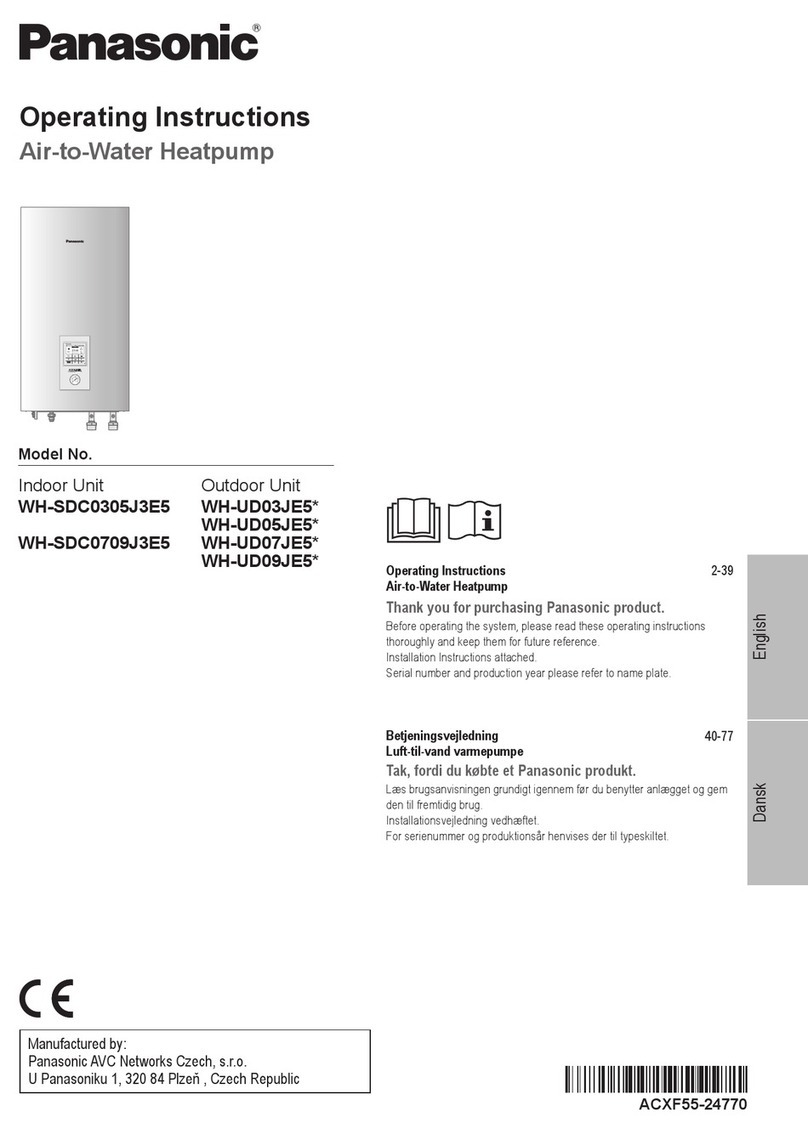
Panasonic
Panasonic WH-UD09JE5 operating instructions

AQUAHEAT
AQUAHEAT SF010P G/Evap Installation instructions manual

nilan
nilan Compact P user manual

Dimplex
Dimplex SI 75ZSR Installation and operating instructions
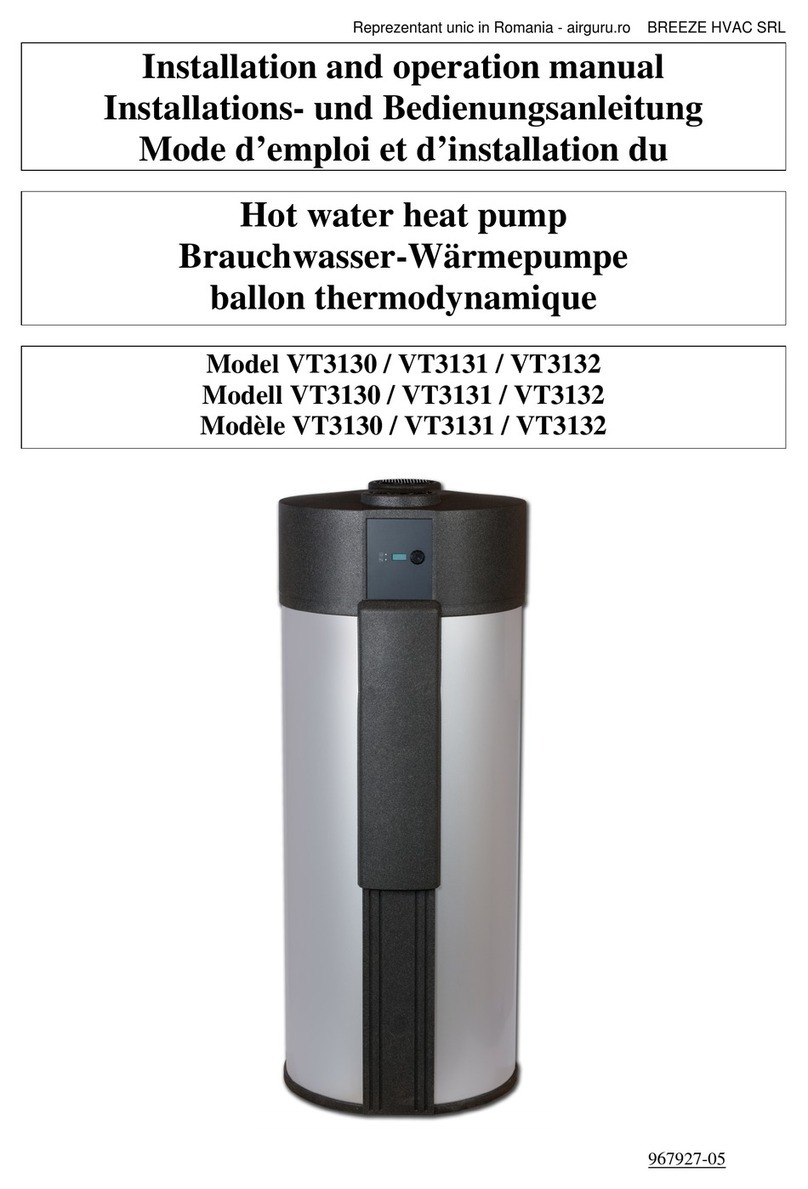
Breeze
Breeze VT3130 Installation and operation manual
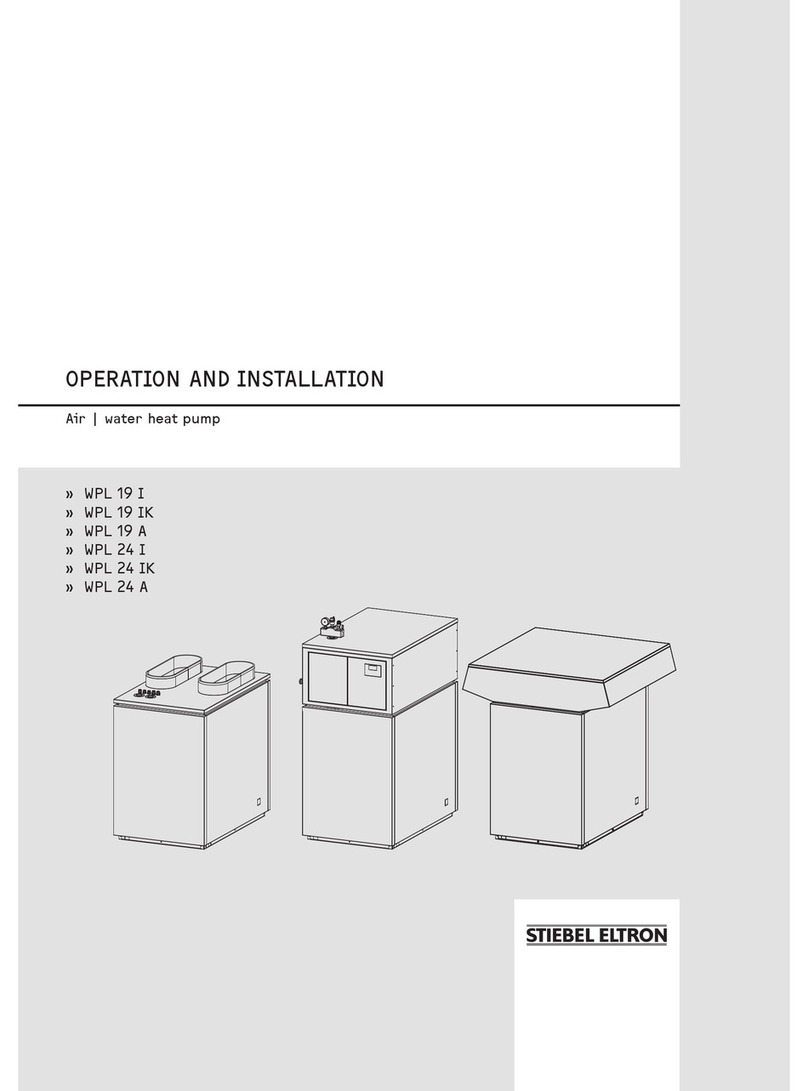
STIEBEL ELTRON
STIEBEL ELTRON WPL 19 A Operation & installation

Heiko
Heiko Thermal 6 installation manual
